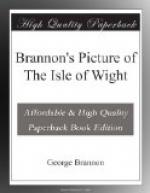“Smile
with charms
CONGENIAL TO THE SOIL, and
all its own:
For
Ornament
When foreign or fantastic,
never charmed.”
>>The reader who may
feel an interest on this subject is referred
to pp. 36 and 43 of
the “Vectis Scenery.”
The most delightful residence at Bonchurch is called EAST DENE: the beauty of its locality is unrivaled; the exterior of the house in a chaste style; and the interior fitted-up and furnished at a great expense in the antique mode of the 16th century.
[Illustration: THE PARISH CHURCH OF BONCHURCH ISLE OF WIGHT]
The Tourist should certainly visit the old Church, which stands near the shore, and not far from the road, though concealed from it by a lofty ridge of the fallen cliff: it is of simple construction, but beautifully canopied by a grove of magnificent elms, and is supposed to have been built in the 11th century,—which is taken as a proof that this part of the Undercliff was certainly in a state of repose at the time of its erection; and has undoubtedly remained so ever since. Still, we cannot question for a moment, but this spot must have been in some previous age (judging from analogy,) subjected to the same catastrophes which we have witnessed even in our own time in its immediate neighbourhood at East End. There is also a new Church, of a neat design, beautifully nestled amongst the rocks in the higher part of the village.
As ROCK, in this part of the island, constitutes the chief source of picturesque effect, it would be an omission not to point out two crags which have gained quite a celebrity for their age and beauty: the first is Hadfield’s Look-out, boldly rising from the road; the other a prominence in the face of the upper range of precipices, called the Pulpit Rock: the former has generally the appendage of a flag-staff,—the latter a rude cross, in unison with its name.
The road through the valley of Bonchurch presents a most enchanting scene: shaded by noble trees; and edged by bold rocky knolls,—and a small pellucid lake and stream, beyond which appears a romantic tract of broken ground and wild brushwood, backed by the venerable grey land-cliff and the lofty brow of St. Boniface Down. On emerging from this beautiful spot, we have on our right a genteel residence called ST. BONIFACE HOUSE, situated close at the foot of the high down which gives the name; built in a very chaste rural style; and embellished by some noble trees, and a sparkling rill.




